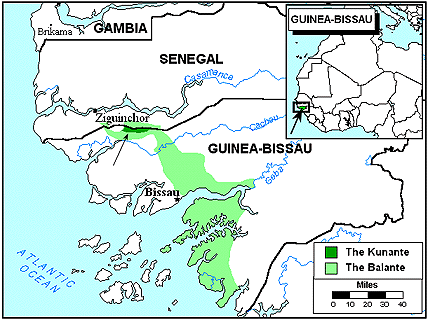The Kunante or Maswanka are located in the north-central region of Guinea-Bissau.
along the border of Senegal. Others live in Gambia. The various peoples of this region of Africa are collectively known as Sene-Gambians because most reside in Senegal and The Gambia. Many scholars link the Maswanka to the neighboring Balante, who are a sub-group of the Jola. Their language, called Mansoanka, is a member of the Niger-Congo language family. They can be called either Maswanka or Kunante, but for simplicity's sake, we will call them Maswanka, the name they use in Gambia.
Like most of the people in West Africa, the Maswanka are probably farmers who grow a variety of crops using basic tools. Maize, manioc, peanuts and rice are the staple foods of this region. Squash, melons, sweet potatoes, peppers, and tomatoes are their vegetables. Their fruits include bananas, coconuts, mangoes and papayas. Maswanka people gather wild fruits and roots; berries, kola, shea and palm nuts. The Maswanka raise cattle, sheep, and goats but do not use their milk. Almost every village has plenty of dogs and chickens. Hunting is of less importance than agriculture.
The Maswanka live in extended family compounds, each consisting of a cluster of huts usually arranged in a circle around an open space. Often, the entire compound is surrounded by a fence, hedge or wall. The compounds usually adjoin to form compact villages. In general, the dwellings are round with mud walls and cone-shaped, thatched roofs. However, many local variations exist.
In Maswanka community, men hunt, fish, clear the land and tend cattle. The women do the gathering and help some with the agricultural work. Chiefs exercise political authority in the villages. Succession usually passes to the next brother or to the oldest son of the deceased's oldest sister.
Males are circumcised during initiation ceremonies at puberty and typically involve a period of instruction in an isolated "bush school."
The Maswanka prefer cousins as marriage partners. The groom's family pays a bride price in livestock in addition to a time of bride service to her family. Polygyny (having more than one wife) occurs to only a limited extent. In such cases, however, each wife has her hut, and the husband spends a fixed period with each on a rotation basis.
Most of the population of the region are ethnic religionists, still following traditional beliefs. However, many (primarily the Fulani and Malinke) are Muslims. Few of the people are Christians. Among the Maswanka, the majority are Sunni Muslims. The rest are either Christians or animists, believing that non-human objects have spirits.
The Maswanka have gospel recordings available in their language. Leadership and discipleship materials are needed to further the growth of the Church.
Pray for the Holy Spirit to give the Maswanka people a greater spiritual hunger that will lead them to the only savior.
Ask the Holy Spirit to anoint efforts to win, equip and send Maswanka Christian believers to the nations.
Pray that God will raise up strong leaders among the Maswanka believers, who will disciple others.
Scripture Prayers for the Maswanka, Kunante in Guinea-Bissau.
| Profile Source: Joshua Project |












